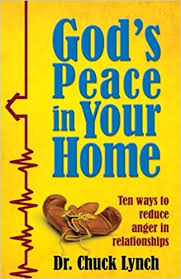- STORE
- >
- Dr. Chuck Lynch Materials
- >
- Gods Peace In Your Home - Ten Ways To Reduce Anger in Your Home by Dr. Chuck Lynch
Gods Peace In Your Home - Ten Ways To Reduce Anger in Your Home by Dr. Chuck Lynch
SKU:
$14.00
$14.00
Unavailable
per item
“Peace in my home? Is it possible?” With 50% of marriages failing and with many adult children wanting to move as far away as possible from their birth families, the evidence does not seem to support the possibility of peace whether in a traditional, blended or single-parent family. Anger is the number one “peace robber.” But anger, like the red light on the dashboard of your car, is only a notifier that something is in need of attention. It does not blame, shame or condemn. It merely says, “There is a need to be addressed so the car can function better.” It has a positive value. AVOID AT ALL COSTS One of the most common reasons anger is not viewed in a positive light is that there is so little written, spoken or taught about anger from a positive perspective. Dr. Gary Oliver, the Executive Director of the Center for Marriage and Family studies at John Brown University, stated, “In Christian circles, not enough has been written on the positive side of anger.” He estimates that at least 50% of the Christians he has polled view anger from an almost exclusive negative perspective. Psychiatrist Dr. Paul Meier estimates that the cost of improper handling of anger could cause up to 95% of psychological depression and therefore should be avoided at all costs. Yet psychologist Dr. Les Carter would say, “Anger is an emotion that speaks up for a personal need.” Anger could be the most lied about emotion. You will often hear, “I’m not angry, I’m just frustrated.” Well, frustration is anger at 25 miles per hour and rage is about 80 miles per hour. But to admit one is angry could be embarrassing and shameful. MEET AN OLD FRIEND In the first chapter you will meet an old friend of the family, anger. “Friend?” Yes, friend! Over the past fifty years I have asked, “What are the biggest sources of anger you experienced growing up?” Bingo! Many of the same sources kept reappearing. So, I would encourage a person to feel the anger and then follow it down to its source. Often they had never thought about the source, but they were experiencing what Dr. Meier would call the clinical symptoms of depression from suppressed anger: insomnia, decreased energy, irritability, poor concentration, headaches, decreased appetite, even thoughts of suicide. Why do I have people re-feel their anger? So they can find the source and deal with it. THE BIG TEN When people were not shamed or condemned for their anger, it gave them freedom to see what was causing it so they could be released from its grip. The top ten sources of long-term anger repeatedly named were: • Over-protection • Favoritism • Rejection • Criticism • Selfishness • Impatience • Discipline in anger • Perfectionism • Hurts • Irresponsibility GREAT NEWS It is all correctible! You will learn how to identify the needs your anger reveals and the positive steps that lead to personal peace. These steps are “doable!” How do I know? Because of the encouraging reports from clients and readers all over the world. One dad read the manuscript and was so changed that he pre-ordered a case of books to share with friends who have seen that change. BONUS The author takes no personal financial benefit from the book. All proceeds from the book are invested in training people on five continents on how to use these tools to bring God’s peace to their homes. So bless yourself and others as you experience some well-deserved peace.
